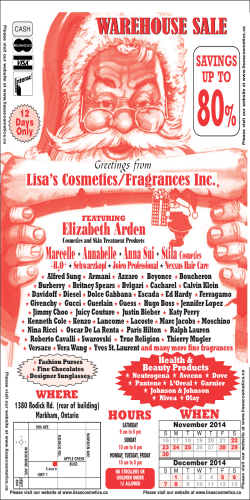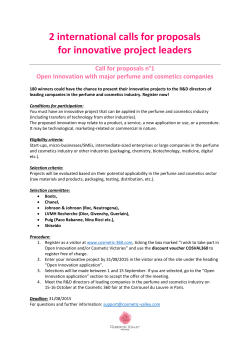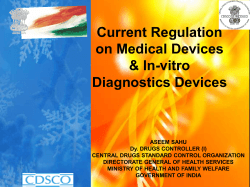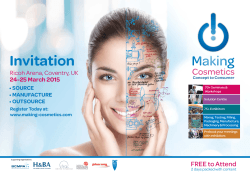
Full File
ISSN: 2249-7196 IJMRR/April 2015/ Volume 5/Issue 4/Article No-2/246-250 Kajapriya R et. al. / International Journal of Management Research & Review AN ANALYSIS ON INSIGHT OF WOMEN CONSUMER’S TOWARDS COSMETIC PRODUCTS Kajapriya R*1, Surya R1 1 M. Phil Research Scholar, Dept. of Management Studies, V.H.N.S.N College (Autonomous), Virudhunagar, Tamil Nadu, India. ABSTRACT In nature, sizeable population of women’s who always concern about their magnificence. Due to this foremost reason our Indian cosmetic Industry has observed a hasty escalation over the last two decades. There are several other motives for the amplified demand for cosmetic products between the women consumers. Hence cosmetic manufacturers are intended to know about women consumer’s insight on cosmetic products. This study is attempted to reveal the women consumers preference, satisfaction and Attitude towards the cosmetic products, Factors influencing and Impact of media which permit the women consumers to buy the cosmetic products. An Interview schedule was framed and collected responses from 120 female consumers of Aruppukottai Town by using convenience sampling method. The data has been analyzed by using Percentage analysis, Chi-square, One Sample T Test and Garrett Ranking. Keywords: Women Consumers, Insight, Demand, Cosmetics and Manufacturers. 1. INTRODUCTION The personal care ingredients market in India is presently esteemed at about $520 million. Products ranging from hair care, skin care & bath products, cosmetics and fragrances from the personal care product market. In India, this industry has developed progressively with the rising practice of specialty ingredients for formulations used in personal care products. In the past few years, this market has seen trends such as – 1) Evolving consumer needs that have led to product differentiation, 2) Increased penetration in urban and rural markets, 3) Innovations driven by market needs, 4) Regulatory regimes driving investments in R&D and 5) Increased consolidation and tie-ups (Personal Care India Expo, UBM India, 2015). The Indian cosmetics market registered impressive sales worth INR 264.1 Billion in 2011, and with rising purchasing power and growing fashion consciousness, the industry is estimated to expand at a CAGR of around 17% during 2013-2015. In addition to this, we found that women are spending more on cosmetics as they are actively earning and spending money on grooming themselves. Besides, rural India is also showing its willingness to look attractive (Indian Cosmetic Sector Forecast to 2015, RNCOS). 2. LITERATURE REVIEW A1–Ashban and Burney (2001) found that cosmetics buying behavior literature in developing countries in general is inadequate and ambiguous. As it is known from Theory of Reasoned Action of planned Behavior, attitudes have considerable impact on behavior. *Corresponding Author www.ijmrr.com 246 Kajapriya R et. al. / International Journal of Management Research & Review Schiffman and Kanuk (2004) revealed four different views are considered for understanding consumer decision making process and behavior. They are ‘economic view’, ‘passive view’, ‘emotional view’ and ‘cognitive view’. Despite the various studies on these four types of decision making but it can be considered as a valid argument that these four behaviors exist while making the buying decision and provide the guideline for the analysis of consumers accordingly by the marketers. Lars Perner (2010) defines consumer attitude simply as a composite of a consumer’s beliefs, feelings and behavioral intentions toward some object within the context of marketing. Shahzad Khan (2012) explained that attitude is the conduct, nature, temperament , thought and way of behaving. It can be positive or negative and perform a very essential function in purchasing a product. Debiprasad Mukherjee (2012) conducted a study entitled ‘Impact of celebrity endorsement on brand image’. This study shows that consumers report higher self-brand connection for brands with images that are consistent with the image of a celebrity that they aspire to be like, particularly in the case when the image of the celebrity and the brand match. 3. OBJECTIVES OF THE STUDY 1. To analyze the women consumers preference towards cosmetic products. 2. To identify the factors that influence women consumers to buy cosmetic products 3. To examine the impact of different advertising medium on women consumers. 4. To obtain the satisfaction level of women consumers towards their cosmetic products. 5. To investigate the women consumers insight on cosmetic products. 4. HYPOTHESIS H1: There is no significant association between the respondent’s age and preference of cosmetics. H2: Consumer’s levels of satisfaction towards the cosmetics they using are not vary from one another. H3: There is no significant difference in the ranks provided by respondents to the Statement related to cosmetic products 5. RESEARCH METHODOLOGY Sources of Data: The study is taken by using both primary and secondary data. The primary data has been collected by using an interview schedule and the secondary data has been collected from magazines, journals and Internet. Sampling Method: A total of 120 respondents from Aruppukottai town were chosen. Convenience Sampling Technique has been adapted for primary data collection. Area of the Study: The study area is restricted to Aruppukottai Town, Virudhunagar District, Tamil Nadu; this town is always prominent for producing yarn. Copyright © 2012 Published by IJMRR. All rights reserved 247 Kajapriya R et. al. / International Journal of Management Research & Review Tools for Analysis: The collected primary data has been sorted carefully by using tables for perfect representation. For the purpose of analysis, the following statistical tools have been used; Percentage analysis, Chi-square test, One Sample T Test and Garrett Ranking. 6. ANALYSIS AND INTERPRETATION Table 1: Demographic Profile of the Female Respondents S. No Women Consumer’s Demographic Variables < 18 19-29 1 Age 30-45 > 46 No Formal Education School Level / Diploma 2 Educational Status Under Graduate Post Graduate Student Business 3 Occupation Status Employee Housewife Source: Primary Data No. of Responses (%) 29 24% 48 40% 34 28% 9 8% 8 7% 27 23% 58 48% 27 22% 41 34% 12 10% 32 27% 35 29% Table 2: Tabulation of Women Consumer’s Responses Women Consumers Preference towards Cosmetic Products Preference towards Cosmetic Products No. of Responses (%) Chemical 28 23% Ayurvedic 29 24% Both 63 53% Factors That Influence Women Consumers To Buy Cosmetic Products S. No Influencing Factors No. of Responses (%) 1 Quality 42 35% 2 Brand Reputation 10 8% 3 Skin concern 48 41% 4 Friends/Family 9 7% 5 Status Symbol 11 9% Impact of different advertising medium on women consumers S. No Advertising Medium No. of Responses (%) 1 Television/Radio 83 69% 2 Newspaper/Magazine 18 15% 3 Internet 19 16% Satisfaction Levels of Women Consumers towards their Cosmetic Products S. No Levels of Satisfaction No. of Responses (%) 1 Very High 34 28% 2 High 26 22% 3 Moderate 21 18% 4 Low 23 19% 5 Very Low 16 13% Women Consumers Insight on Cosmetic Products No. of Responses (%) S. No Statements Ranks 1 2 3 4 1 I prefer purchasing well known brands of cosmetics 33 29 18 24 2 Higher the price of a cosmetic, the better its quality 26 31 12 33 3 Once I like a brand, I stick with it 52 34 12 18 4 Highly cautious towards using new brands 38 27 15 24 5 Most advertised cosmetics brands are good choice 22 19 26 31 Source: Primary Data S. No 1 2 3 Copyright © 2012 Published by IJMRR. All rights reserved 5 16 18 4 16 22 248 Kajapriya R et. al. / International Journal of Management Research & Review Table 3: Chi-Square Tests Value df Asymp. Sig. (2-sided) a Pearson Chi-Square 8.372 6 .212 Likelihood Ratio 7.974 6 .240 Linear-by-Linear Association .001 1 .971 N of Valid Cases 120 a. 3 cells (25.0%) have expected count less than 5. The minimum expected count is 2.10. Source: Computed Data The above table shows the p value (0.212) which is greater than the assumed value of 0.05 (Level of Significance). Hence H1 is accepted. Therefore, there is no significant association between the respondent’s age and preference of cosmetics. Table 4: One Sample T Test Test Value = 0 t Level of Satisfaction towards their Cosmetic Products 25.846 df 119 Sig. (2-tailed) .000 Mean Difference 95% Confidence Interval of the Difference 3.32500 Lower Upper 3.0703 3.5797 Source: Computed Data The above table shows the p value (0.000) which is lesser than the assumed value of 0.05 (Level of Significance). Hence H2 is rejected. Therefore, Consumer’s levels of satisfaction towards the cosmetics they using are vary from one another. Table 5: Garrett Ranking Test S. No. Statements 1 I prefer purchasing well known brands of cosmetics 2 Higher the price of a cosmetic, the better its quality 3 Once I like a brand, I stick with it 4 Highly cautious towards using new brands 5 Most advertised cosmetics brands are good choice Source: Computed Data Total Score 6475 6180 7360 6580 5880 Average 53.96 51.50 61.33 54.83 49.00 Rank III IV I II V The above table represents that the statement “Once I like a brand, I stick with it” is ranked one by high number of respondents. This table clearly indicates that there is a significant difference in the ranks provided by respondents to the Statement related to cosmetic products. Hence H3 is rejected. 7. FINDINGS Around 53% of respondents prefer both chemical and Ayurvedic based cosmetic products irrespective of their age, education and occupation status. 41% of the respondents are influenced by the factor of ‘skin concern’ to use the cosmetic products and followed by the factor ‘quality’ which influences 35% of consumers to use cosmetics. Advertising medium ‘Television/Radio’ created an impact on 69% of women consumers to buy cosmetic products. 28% of women consumers are very highly satisfied with the cosmetic products they make use of. There is no significant association between the respondent’s age and preference of Copyright © 2012 Published by IJMRR. All rights reserved 249 Kajapriya R et. al. / International Journal of Management Research & Review cosmetics. , Consumer’s levels of satisfaction towards the cosmetics they using are vary from one another. There is a significant difference in the ranks provided by respondents to the Statement related to cosmetic products. 8. SUGGESTIONS AND CONCLUSION The cosmetic Industry is supposed to identify the cosmetic user’s expectation and their attitude towards the cosmetics that cheers both manufacturers and consumers with regards to cosmetics. Product modification or change in product design or enriching the quality of the cosmetics which retain the loyal customers of that particular cosmetic brand. Innovation is a key to triumph. Classy promotional mix can facilitate in drawing customers with regular offers which should also come up with the new trend. Irrespective of age, women consumers prefer the cosmetic products, so the producers could target all age category of consumer’s to prop up their products. REFERENCES [1] Ashban A, Burney. Key antecedents to cosmetics use among women in Saudi Arabia: Empirical evidence from Saudi Arabia. JISSM 2001; 9: 3-20. [2] Mukherjee D. Impact of celebrity endorsement on Brand Image. Indian Journal of Marketing 2012; 42: 19-22. [3] Indian Cosmetic Sector Forecast to 2015, RNCOS, Business Consultancy Services. Retrieved on 22.03.2015 from http://www.rncos.com/Market-Analysis-Reports/IndianCosmetic-Sector-Forecast-to-2015-IM388.html. [4] Perner L. Consumer Behavior: the psychology of marketing, 2010. Retrieved on 21.03.2015 from http://www.consumerpsychologist.com/ [5] Personal Care India Expo – 2015. UBM India. Retrieved on 21.03.2015 from http://www.ubmindia.in/personalcareindiaexpo/about [6] Schiffman, Kanuk. Consumer Behavior, 2004, 8th edition, Pearson Education International, Prentice Hall. [7] Khan S. Factors affecting buying behavior of females for purchase of cosmetics’. International Review on Business and Social Sciences 2012; 1(9): 68-76. Copyright © 2012 Published by IJMRR. All rights reserved 250
© Copyright 2025










